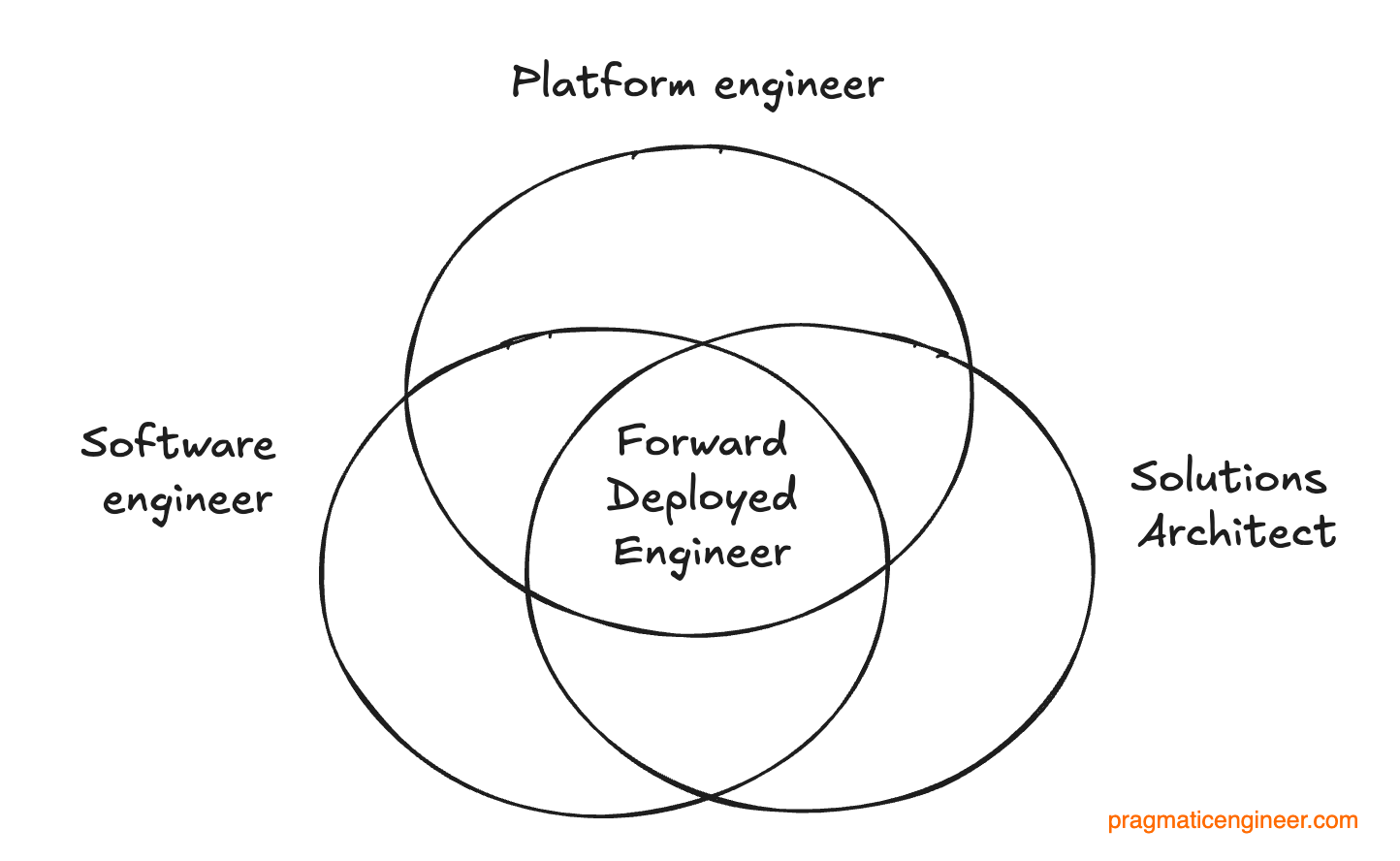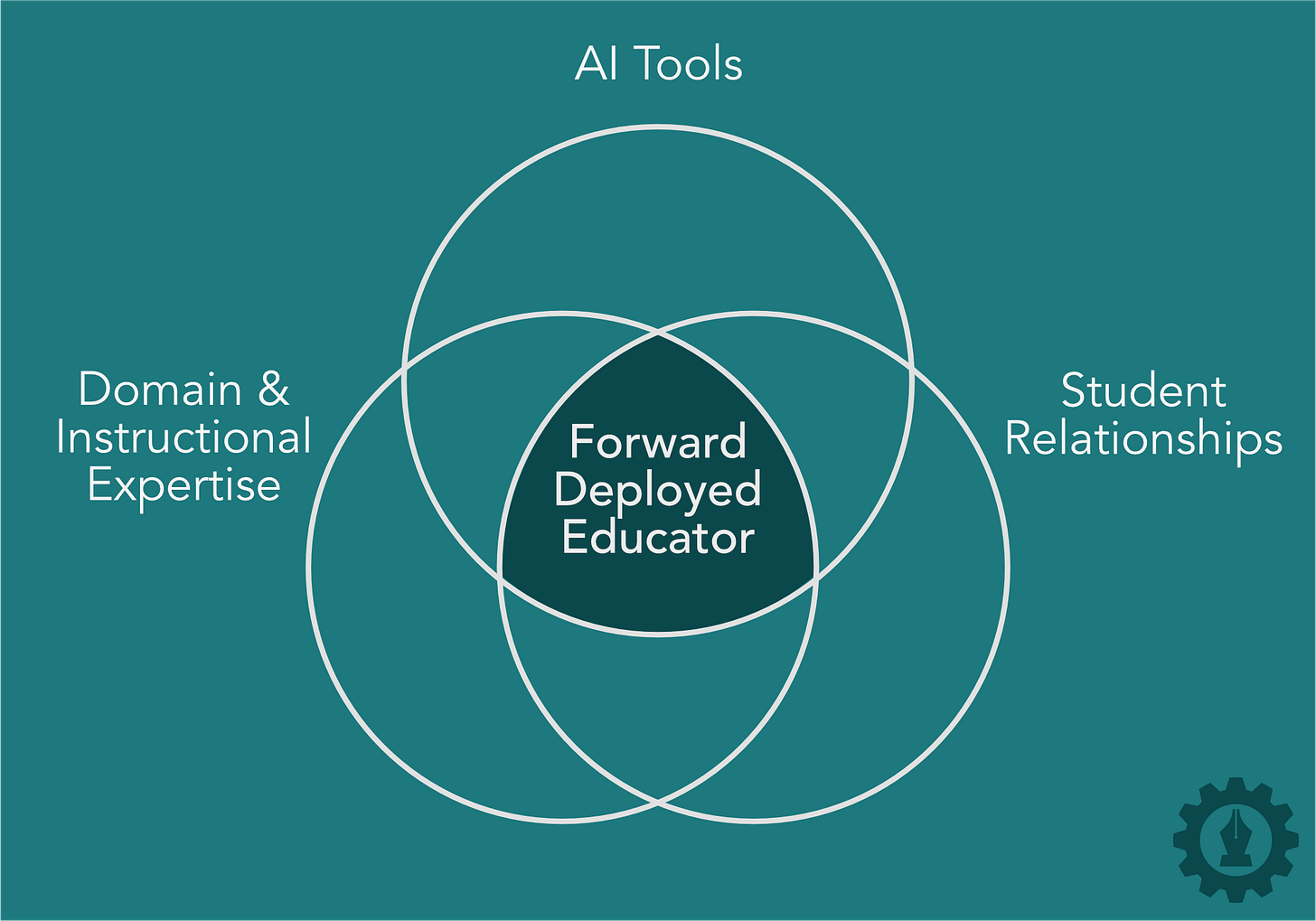The Forward Deployed Educator
How the combination of domain expertise, relationships with students, and AI tools can amplify your ability to create engaging learning environments
Thank you for being here. Please consider supporting my work by sharing my writing with a friend or taking out a paid subscription.
If you’ve been following the conversations in the AI startup world over the last few months, you may have heard about a new role that is becoming popular among AI startups. It’s called the “Forward Deployed Engineer” or FDE, for short. The idea of forward deployment isn’t just useful in the context of engineering; it also captures how AI can be used to make educators even more effective at the work that only they are able to do, work that requires personal, human relationships with their students.
I call this the Forward Deployed Educator.
The Power of Resources in Proximity to Problems
The power of the FDE concept is proximity to the stakeholder. In a standard way of doing engineering, the engineers are situated within their company’s offices, doing their work based on feedback that trickles back to them from customers either via public-facing feedback, analytics, or internally from the salespeople and field engineers who are directly interacting with the customer. This creates a significant latency between discovering a problem or opportunity and building a solution to address it. Not only does this latency limit how quickly a team can respond, it also makes it challenging to iterate quickly and prototype.
In contrast, the FDE model takes the engineer and situates them directly within the stakeholder’s organization. Instead of being at the base, they are deployed at the frontier, directly adjacent to the problems. This greatly reduces latency in communication between the customer and the solution architect, enabling a much more responsive mode of working.
Historically, the challenge with deploying engineers like this is that they would lack the resources needed to effectively address problems. This is still true in many domains. For example, anywhere that significant physical resources are needed, the FDE model has limited power. That’s because although you deploy the engineer in close proximity to the problem, they don’t have all that they need to address it. Imagine if a contractor didn’t bring their tools and building materials to a job site. They’d be endlessly running back and forth to the local hardware store and end up spending more time on the road than they would moving the project closer to completion.
The Resources Provided by GenAI’s
This is where AI has changed the game. Generative AI and the set of tools that are being built around it have made it possible for engineers to operate within the stakeholders’ context in new ways.
talks about this in a post a few months ago, where he included the figure below.
In this Venn diagram, the Forward Deployed Engineer is able to draw on the overlap of her skills to create software, architect solutions, and build platforms. Each of these is enhanced by generative AI, enabling more effective resourcing at the frontier.
The Forward Deployed Educator
As I continue to spend several hours a day in AI-powered coding tools like Claude Code, I’m increasingly convinced that a similar mode of operation is now available to educators. If you’re a bit skeptical, I don’t blame you. Educational technology, after all, often overpromises and underdelivers. Writing software and helping students learn effectively are two very different things.
But the biggest failure of most educational technology is that it has too little connection to educators themselves. Educators are the ones with the context of their subjects and classrooms, the pedagogical training to know what they are trying to help their students achieve, the rationale to articulate why they're trying to achieve it, and the relationships with their students to help connect the dots. Together, this means that educators are already forward deployed, in a way. They are at the interface between the curriculum and the students.
The emergence of tools like Claude, ChatGPT, and Gemini—and the command line interface tools like Claude Code that are built on top of them—means that educators now have the tools at their disposal to create bespoke active learning tools for their classrooms. These tools are not some generic, one-size-fits-all solution, but tools that can be customized to their particular curriculum, disciplines, and students.
I’m thinking here about the kind of interactive visualizations that can often be a very useful tool for helping students to build intuition about a concept, and enable them to engage in curious play. It’s interactive single-page web apps that help students to test their knowledge on assembly and machine language in my digital design and computer engineering class. It’s a custom multitasking simulator to help students visualize how different scheduling algorithms perform and impact the performance and context switching overhead in a real-time operating system. Now, instead of being frustrated with the limitations and constraints of existing tools that don’t do quite what you want or the insurmountable time investment required to build a small tool to illustrate a concept in a single lesson, you can get to a serviceable demo in only a few prompts.
The idea of the Forward Deployed Educator ties together themes from several other educators that I follow. Earlier this year, my friend
shared a Unit Circle Demo that he mocked up with GPT-o1 to show the connection between sines, cosines, and the unit circle. In a post a month later, he mused how even incorrect simulations can be used to help push students to be more curious and to develop healthy skepticism. Just yesterday, wrote about the Writing Gym Tracker app that he built to help his students build their writing practices. In the before times, you’d have to live with the limitations or bugs in another developer’s app, bugging them to fix or add the features you want. Now you can just build and deploy your own with a few prompts.Prototyping Forward Deployed Education
Ok, let’s assume that my argument piques your curiosity. What then? How exactly do you prototype the FDE model?
Here’s how I would get started. Together, these three steps leverage each of the habits in the Forward Deployed Educator Venn diagram. They are:
Build a set of learning outcomes (Domain Expertise)
Think about what your students need (Student Relationships)
Use Claude (or pick your favorite AI tool) to build a simple active learning activity for your class this week. (AI Tools)
First, start with the learning outcomes. Explicitly articulating learning outcomes is one of the most valuable practices that I’ve developed as an educator. Writing down concrete skills and takeaways for students at the end of a course, class session, or an assignment helps to provide a lens through which you can critique and hone the content that you include.
After you articulate the learning outcomes, you must clarify where your students are. The learning outcomes are the desired end state, and the preexisting student knowledge and skills describe where you need to meet your students to bring them there.
Then, once you have these two in place, you’re ready to use AI to prototype. Starting with the information you wrote down in the first two steps, use that as the foundation for your prompt. Don’t be worried about getting the prompt just right. Remember, iteration is the name of the game.
As you craft your prompt, the more explicit you can be about what you want, the more likely you are to get something close to what you’re shooting for. If you have a vision of the artifact you want to prototype, great! Write a paragraph or two to articulate that idea. But if you don’t, that’s also fine. The beauty of working with LLMs is that they can help you to generate and refine some ideas.
Here are a few pieces that you’ll likely want to include in your prompt. You can use the template below to format it, or simply ask your AI tool to help you create it. You can always make your prompt more complicated, but it’s a good idea to start with three main pieces:
Context: The purpose of the tool.
Guidelines: What the app should do and how it should look, feel, and operate
Constraints: Things the app should not do
Here’s a start prompt that I played around with for my real-time operating system simulation app. It’s still a work in progress, but if you want to grab something to copy and paste into Claude to give it a whirl, give this a try just to see how it works.
## Context
I am creating a simulation for students in my undergraduate engineering class at Harvey Mudd College to help them understand task scheduling in real time operating systems. I want to create a simulation that enables them to create custom tasks with different priorities, durations, and offsets and allow them to customize the tasks running so that they can see how different scheduling algorithms behave. Make sure that the logic for scheduling is correct.
## Guidelines
- Make the UI/UX simple and streamlined.
- Give information about each scheduling algorithm so that students can understand the basic heuristic.
- Make the tasks editable with three different editable parameters (name, duration, priority, and offset)
- Make it possible for students to start, pause, and reset the simulator.
## Constraints
- Include no more than three scheduling algorithms.
- Do not include additional features that I did not specifically ask for
- Do not use more than two fonts and four colors in the interface.Opportunities and challenges are two sides of the same coin
In so many ways, it’s an extremely challenging time to be an educator. In addition to the new pressure that generative AI is placing on educators, the continual need for more resources and the aftereffects of COVID-19 continue to exist in the background. But every challenge is an opportunity for innovation.
Despite the threats that generative AI poses for education, there are new opportunities that are simultaneously emerging for teachers to create new ways for students to engage in new and meaningful learning opportunities. The mindset of a Forward Deployed Educator offers one of those fruitful directions.
Got a thought? Leave a comment below.
Reading Recommendations
This post from
on how he uses Claude Code was a good read. It’s a nice concise summary of the features available and how you might experiment with them.The folks over at every.to publish interesting content on how they are using AI. Every is an interesting organization because they run in both the development and thought leadership lanes. This piece from Kieran Klaassen explains how he is using Claude Code in his workflow.
I first discovered
a few weeks ago on Twitter. This week, I happened to come across this video on how he uses Claude Code in his programming workflow. I remain convinced that the best way to learn this stuff is by watching other people do things and then trying it yourself.The Book Nook
Not as much reading happening lately, because I’m either cooking in Claude Code or watching Silo.
The Professor Is In
Really enjoying learning some new tools recently. Been really impressed and enjoying Railway for quickly deploying whatever new app I’m building. They also have a nice feature where you can easily deploy existing apps with just a few clicks. An instance of NocoDB, my favorite open-source no-code database app, featured above.
Leisure Line
Got some delicious brioche bread from Crème this week. Made some killer French toast.
Still Life
Of course, when you are at Crème you can’t just get bread, you have to get a pastry too. Pumpkin muffin pictured. If you’re in the Village and wondering where it is, just look for the line fifteen people deep on the sidewalk.










Perhaps unsurprisingly, I don't love it. In many ways, educators in the K12 space have been curating their own curriculum in similar fashion using sites such as Teacher Pay Teachers. That site and other like it are a wasteland of terrible lessons and task ideas that nonetheless get can great traction for all the wrong reasons (easy to implement, students may enjoy them, but no learning takes place). It's not clear to me that AI-produced materials are substantially better; my trial usage suggests they are often worse.
I think it's important to be careful not to "optimize" around what the most thoughtful teachers will do. The real test is how it cashes out with the practical day-to-day realities. And I've seen versions of this movie before.
What a fascinating concept! This model could be used in so many sectors to improve innovation and adaptation of capabilities.